Posted: May 16th, 2013 | Author: Nathan | Filed under: found sound objects, sound design
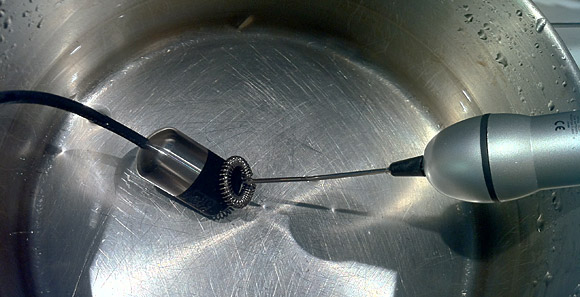
This thing was given to me as a Christmas gift. I immediately wanted to not froth milk with it, but to record it. With a hydrophone.
It was initially disappointing…until I put it into a metal pan and realized that its interaction with the pan, not the water, was far more interesting. The hydrophone was still in the water, but the frother was used in the water, inside the pan, and outside the pan as well, at varying speeds.
[soundcloud url=”http://api.soundcloud.com/tracks/73914784″ params=”auto_play=false&show_artwork=false&color=ee0000″ width=”100%” height=”166″ iframe=”true” /]
[Aquarian Audio H2a-XLR hydrophone into Sound Devices 702 recorder]
Tags: hydrophone, metal, sound design, sound effects | No Comments »
Posted: December 2nd, 2012 | Author: Nathan | Filed under: field recording, nature recording, sound design
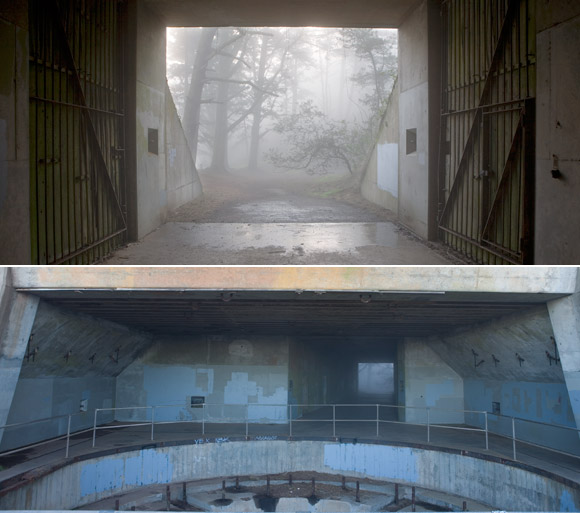
“Construction 129,” a never-completed gun emplacement overlooking the entrance of the Golden Gate, Fort Cronkhite, Marin Headlands, California.
When a winter storm was forecast for the San Francisco Bay Area, I decided to head to the Marin Headlands and try my luck recording bad weather in the abandoned gun emplacements and military fortifications of Fort Cronkhite. I had previously found some great metal sounds at Fort Baker, also in the Headlands, and I was also inspired by Tim Prebble’s high-wind-sub-bass-generator post.
Unfortunately for me, the storm track was slower than predicted, and I wasn’t able to record in peak wind, although some moderate rain started to fall. Such things happen, even with the best of intentions. So, what do you do when your primary plan doesn’t pan out? You reset your expectations and record what you can. I mean, c’mon, I’m in these amazingly evocative ruins! Surely there’s something that’s audibly interesting!
So, I decided to record rain in the tunnels. A recent re-viewing of Ridley Scott’s Prometheus reminded me that tunnels and caverns in films often feature water drops that are drenched in heavy reverb. I pressed the “record” button in several settings and closed my eyes: Was I in the bowels of an ancient spacecraft? The Mines of Moria? The hull of a leaky, empty freighter?
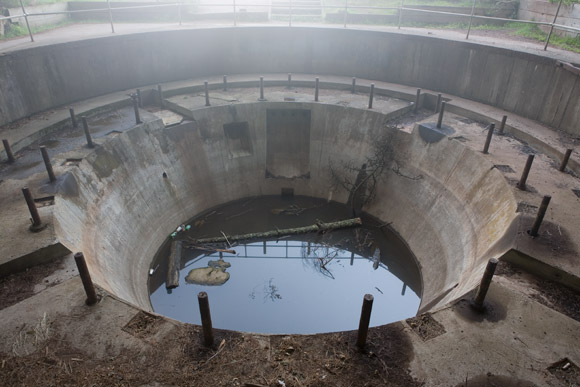
The gun emplacement at Construction 129. No weapon was ever installed.
Occasional wind blasts forced me to enable a high pass filter at 120Hz to try to remove some of the ambient rumble that didn’t help the recording. In addition, there are no fewer than three foghorns in the Marin Headlands, so I had to make an edit every 50 seconds to eliminate the lonely bleat of the Point Bonita lighthouse horn.
There is always something worth recording. You just need to let your disappointment go, reset your expectations with some beginner’s mind, and just start rolling.
[soundcloud url=”http://api.soundcloud.com/tracks/69735256″ params=”auto_play=false&show_artwork=false&color=ee0000″ width=”100%” height=”166″ iframe=”true” /]
[Sennheiser MKH 30/50 mid-side stereo pair into Sound Devices 702 recorder]
Tags: field recording, nature recording, rain, ruins, sound design, sound effects, tunnel, water | 2 Comments »
Posted: December 1st, 2012 | Author: Nathan | Filed under: field recording, gear

The Nexto DI NVS1501 is a burly, professional, and pricey way to back up flash media in the field without a host computer.
[Editorial note: This is an expression of my opinions about this piece of equipment. It was purchased and not provided by the manufacturer. I have no relationship with any company listed below.]
There aren’t many options available for in-the-field, no-computer backups for those of us recording to flash media, like Compact Flash cards, Memory Sticks, and SDHC cards. The most readily-available solutions are usually oriented towards photographers, focusing more on being digital photo albums than professional devices that makes our data more secure, and sometimes only accept JPGs, not arbitrary file types (like, oh, say, .wav files). Some devices, like the Sound Devices 700 series field recorders, will let you write to two pieces of media at once, but what about trips so long that you might need to reclaim CF card space? Or the other devices that we bring with us, like cameras, which can’t do that? Or the majority of trips that I take where carrying a laptop is more hassle or risk than it’s worth?
Enter Nexto DI, a little-known Korean manufacturer of field backup devices oriented towards filmmakers and cinematography digital imaging (DI) technicians. I decided to try the Nexto DI NVS1501 in its 500GB size as a field backup device for four specific pieces of media-capture gear, which could all be in my kit on some trips: the Sound Devices 702 field recorder, the Sony PCM-D50 handheld field recorder, the Canon 7D DSLR, and the GoPro HD Hero 2 POV camera.
Read the rest of this entry »
Tags: audio equipment, backup, field recording, review, travel | 3 Comments »
Posted: November 20th, 2012 | Author: Nathan | Filed under: theory
Randy Coppinger recently wrote a great blog post recently about not getting caught up in tool choices or being dogmatic about approach, and just focusing on the problem at hand, tools be damned. I couldn’t agree more.
This reminded me of a corollary to Randy’s thesis: The tools we use shape what we create.
While that’s perhaps self-evident, that’s not always a good thing. Tools can be creatively inspiring, but they can also become handcuffs, blinding us to better ways of working. Or, even more sinister, subtly changing our work to be something other than we intended.
If you’re a woodworker, what you can do without a lathe can be pretty limiting. Or a jigsaw. Or a coping saw. If you have all of these things, your creativity can be freed from many restrictions, since you are removing constraints upon your ability to execute your ideas. Such restrictions can really get in the way of earning a living in a crowded marketplace. A car mechanic, for example, won’t get a lot of work if he doesn’t have a hydraulic lift and an impact wrench.
So it goes with digital creative professionals. A visual designer these days can’t operate without a computer, and it’s a tough life without Adobe Photoshop. An audio professional can’t work without a DAW, and it’s hard to be competitive if you don’t know ProTools reasonably well. A field recordist needs microphones. And so it goes.
But microphones or recording techniques can have certain tonal characteristics, just like how raster artwork (e.g., created in Photoshop) looks different than vector artwork (e.g., created in Illustrator). It’s important to realize that the tool choices we do make aren’t always going to be neutral. Every tool choice imparts some color to our output. Rendering one’s idea in charcoal will be emotionally quite different than rendering it in pencils. Different sizes and shapes of chisels affect the texture of a sculpture. Capturing a sound with a Rode NT1a will sound different than with a Neumann TLM-103, even on the same material and from the same perspective, yielding different emotions and tones when listened to.
None of us can afford a warehouse of infinite tools…the Tardis tool shed doesn’t exist. But neither is poverty an excuse to not be aware of your tools’ influence on your work. Knowing the attributes of your microphones lets you know what you might want to modify and sculpt audio recordings in post, just as a woodworker might use fine-grit sandpaper by hand for those last touches that really give a piece the personality of the artist, not just the texture of his or her tool’s “fingerprint.” A person on a limited budget and constrained equipment can achieve greatness by adding tons of knowledge and insight. A metalworker with limited tools might only be able to create things of a certain scale, just as a limited-resource recordist might pick only certain subjects to record due to the limitatons of his or her kit.
Randy’s point is one that I absolutely agree with: Properly frame the problem and establish a conceptual framework for solving it, and let that dictate the tools you use. Don’t always rely on the old standards. Expanding this line of thinking, however, forces you to also look long and hard at the tools you use. Always be slightly suspicious of your equipment, which influences and colors what you create. That can be wonderful and enhance the source material. Or horribly inappropriate and lose the character of the original. But there’s a big difference between being conscious of those differences and being blind to their influence on your work. That way lies ambivalence, which I’ve written on before.
A common phrase on Jeff Wexler’s production sound forum regarding equipment versus the user goes something like, “It’s not the arrows, it’s the archer.” Knowing your arrows’ quirks lets you play with the results. And that’s where a creative professional moves from being an informed craftsperson to becoming an empowered artist.
Tags: art, creativity, design | 1 Comment »
Posted: November 20th, 2012 | Author: Nathan | Filed under: nature recording
I was sick at home one fall day and I heard a European starling singing. Loudly. I didn’t see it outside of any doors or windows, all of which were shut anyway, and then realized that it was perched on my chimney, and therefore was singing right into my house.
All my high-end nature recording mics were in my closet; nothing was hooked up and my batteries might not have been charged. So, even with oodles of gear around, I just grabbed my handheld Sony PCM-D50 that was right on my desk, and started rolling.
Of course, the chimney did an equally good job funneling nearby road noise. Perhaps its narrow aperture did some pre-filtering on that background noise, as it was pretty easy to remove using iZotope RX. It also helped that the signal to noise ratio was very high, given the bird’s proximity relative to the ambient noise. (Tip: Ever use Strip Silence on birdsong? Try it. Super weird!)
[soundcloud url=”http://api.soundcloud.com/tracks/67803896″ params=”auto_play=false&show_artwork=false&color=ee0000″ width=”100%” height=”166″ iframe=”true” /]
[Sony PCM-D50, 90° capsule spread]
Tags: animals, birds, birdsong, nature recording | No Comments »
Posted: November 12th, 2012 | Author: Nathan | Filed under: field recording, sound design

The Uptown, Mission District, San Francisco. Photo source unknown.
The Uptown is the closest bar to my office, and is a classic Mission District hipster dive bar. One hot, Indian Summer day in the fall, it was filled with patrons, windows flung open…but the jukebox was off. And everyone was concentrated by the bar and front door, leaving the back area empty.
Anyone who tries to record diffuse crowd sounds, or “walla,” knows that this is a golden moment. Human voices, but little intelligible conversation, no background music, not too far away from the noise source. I ordered a beer, sat as far away from everyone as I could, and started rolling on my handheld recorder.
I did a little trickery by taking a segment of the recording, swapping the left and right channels, and layering it with another segment, to effectively double the number of people in the room. Luckily there wasn’t too much background noise to also get multiplied. Perhaps not the most interesting of moments on its own, but the little details of the cash register ring, squeaky door hinges, and the general density of the human sounds represents (to me, anyway) a surprisingly hard-to-capture scene without the intrusion of music.
[soundcloud url=”http://api.soundcloud.com/tracks/37831942″ params=”auto_play=false&show_artwork=false&color=ee0000″ width=”100%” height=”166″ iframe=”true” /]
[Sony PCM-D50 recorder, capsules at 120°]
Tags: ambience, sound design, sound effects, urban, voice | No Comments »
Posted: October 31st, 2012 | Author: Nathan | Filed under: field recording, sound design
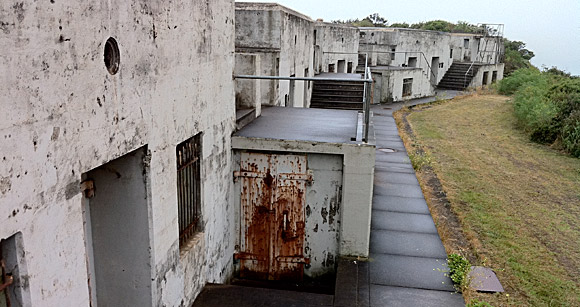
Battery Yates, Fort Baker, Sausalito, California.
Over a year ago, I posted some scraping metal sounds from the steel doors of Fort Baker’s Battery Yates, right at the Golden Gate of the San Francisco Bay. I recently unearthed some metal hits from that same session: They’re heavy, resonant, and the concrete rooms behind them certainly lent the sound some nice air in the low end. (Read the previous installment if you want to learn more about this location and how it was recorded.)
And, since today is Halloween, the original sounds are presented in both their original form and pitched down by an octave for extra heaviness and spookcreeptacularness.
Enjoy the clanky, boomy fun…and happy Halloween!
[soundcloud url=”http://api.soundcloud.com/tracks/65535342″ params=”auto_play=false&show_artwork=false&color=ee0000″ width=”100%” height=”166″ iframe=”true” /]
[MKH 50 microphone into Sound Devices 702]
Tags: creepy, field recording, industrial, metal, resonance, San Francisco, sound effects | No Comments »
Posted: October 16th, 2012 | Author: Nathan | Filed under: news
Thanks to the just-darned-lovely and ubermensch Shaun Farley, I’ll be on a panel at the 133rd AES Convention in San Francisco this October 28, 2012 at 4:15pm. We’ll be talking about breaking into sound design with folks from EA, Skywalker Sound, and much more, with some extremely talented panelists…certainly moreso than me. (I mean, Ann freakin’ Kroeber?!? Sweet.) Hopefully I can contribute my own story into the conversation, coming to sound design from the design angle and the more visual side of things.
If you’re around, I’d just love to say howdy before or after the session. I’ll also be walking the show floor that day, so if you see me, say hi!
[Editorial note: Yes, this site has been quiet recently. Yes, things are great. Just busy. More soon, though!]
| No Comments »
Posted: February 20th, 2012 | Author: Nathan | Filed under: field recording, nature recording, sound design
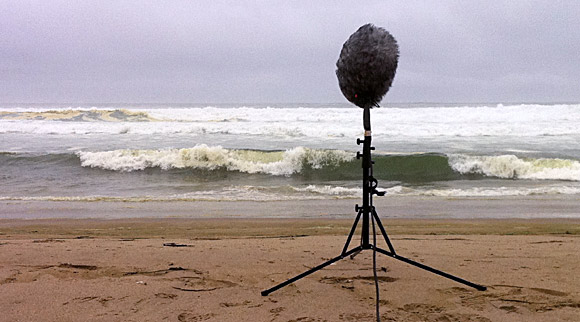
Look carefully: Deep impact zone, short period, wind parallel to the shoreline. Not a good day for recording single waves. So...what is?
It’s easy to get recordings of roaring surf – which can often just sound like constant white noise – but it can be tough to get relatively clean recordings of individual waves. I’ve found that picking a good day and place to record single wave hits are a combination of marine forecasts and location, and that the size of the waves really doesn’t matter.
The only online article I’ve seen that mentions both field recording and marine forecasting has been published by Tim Prebble. In that excellent article, he describes finding gentle-surf days to record his amazing Seal Vocals SFX library. Sometimes finding those small- to moderate-swell days are sometimes the best days to record single wave crashes…but that’s not the only factor.
Single-wave recording conditions are largely defined by a mix of swell, wind, and location.
Swell is due to the large movements of water over great difference; swell is not the same as waves, which are usually wind-driven. Swell is usually forecast based on buoys offshore, and is forecast days in advance. However, I find that 2-day swell forecasts are the most accurate. Swell is defined by wavelength and amplitude, just like audio: Wavelength is is measured in seconds (usually called period), and amplitude (usually called height) is based in feet or meters. Ideally, you want swell with long periods, because that means there’s a greater volume of water moving, but tall swell is also your friend, because that also influences breaking-wave heights at the shore. (Tip: Waves come in “sets” of big and small, between 3 and 8 waves each, depending on if there are multiple wavetrains that are in or out of sync. That means record for far longer than you’d otherwise think in order to get a good range of big vs. small waves over time.)
Getting back to the topic of wind, not all wind is bad (and we all know what wind does to field recordings: huge amounts of badness.) Offshore winds (those that come off of the shore – yes, that is totally confusing!) will might wave faces up longer than they’d be up otherwise, causing a moment of quiet before the wave breaks (or “closes out,” in surf parlance) and a potentially taller wave face. Wind coming onshore (onto the shore from the water) often smears the wave tops and can cause premature toppling…not to mention the fact that the wind will be blowing directly at your microphone capsules. (Tip: You can’t be at the shore without shorebirds, often noisy ones. Bird feeding activity, and therefore noise, may peak before an oncoming storm. Watch the forecast and choose clear weeks with low-pressure days, when it requires more energy to fly, when possible to reduce avian noise. Gulls are complete bastards in this regard!)
Finally, this brings us to location. Some of this is taste: Do you want to record breaking waves against sand, or against rock? Very different sounds will come out of each; bigger crashes will happen on rocks as opposed to sand. But beyond that, know a bit about your location. What direction is the swell and wind coming from, relative to where you’ll be facing? How does the land curve around, creating refraction waves? What is the slant of the land below the shoreline? This last one is especially critical, as the gentler the slope, the bigger the wave. The “impact zone” – where the waves actually break – can be deep or narrow, and a narrower impact zone will generate fewer audible breaking waves at once. Knowing if a beach has a “dumping break” is useful: It makes it terrible to launch from or surf near, but that also means the waves break right at the shoreline, which is far better for audio recording. Just watch out for your gear. (Not a tip, but trivia: Waves always break when the water depth is 1.3x to 1.5x the wave height, as the horizontal energy of the swell gets forced upwards to create breaking-wave heights near shore.)
Never turn your back to the sea. The sea is huge, powerful, indifferent, and above all, unpredictable. Rogue and “sneaker” waves are not legends or myths: They occur regularly, anywhere in the world. Don’t let a recording session end in tragedy.
A final note on technique: If you’re on a beach, angle the mic a bit more downwards than you’d think would be wise, and you’ll get nice sounds of the sand being pulled back as the breaking waves recede back into the ocean. Not always good to have in every recording, but this adds a lot more character. On a beach with fist-sized rocks, this can be especially cool!
I had a recent session at a sandy beach in the Point Reyes National Seashore that exemplified some of the better (but not quite perfect) conditions that I describe above. First, the wind was blowing at 20 knots…but from the opposite direction of the beach I was on, which was backed by hills. That meant delayed wave breaks and being protected from the wind. There was a southerly swell that came right into the dumping-break beach (I can tell the period is averaging 14 seconds by looking at the waveforms of the audio!), so it was all breaking swell and no wind-driven waves. It was a low-pressure day with a long-term clear forecast, and it wasn’t winter, when the masses of migratory birds come through Northern California. Only one swallow’s call made it into the recording.
The recordings aren’t all that dramatic when you consider the breaking waves were only 3-4′ high. But listening to this loud on headphones, eyes closed, I find that the sense of scale is quite exaggerated without an accompanying visual reference…a little Waves LoAir or layering some low-frequency booms can definitely can tip it into cinematically-big breaker territory if desired. However, even in a 90-second clip, there are only three really distinct wave “claps” as the bigger waves close out at the beach.
[Sennheiser MKH 30/50 mid-side stereo pair into Sound Devices 702 recorder]
Tags: field recording, nature, nature recording, ocean, sound design, sound effects, surf, water | 3 Comments »
Posted: October 19th, 2011 | Author: Nathan | Filed under: gear, music, sound design
 There are lots of under-the-radar software toys out there for mangling audio, but one that I have yet to hear anyone really discuss much is Spongefork, created by Ryan Francesconi over a decade ago. It’s been around for a long time, and is intended as a live improvisation instrument. Its incredibly sparse interface belies a lot of sonic mangling possibilities, with multiple sample banks and a live-control XY controller. For $65, it’s a fun toy. (Even the demo fully works, just without the ability to save work.) Heck, I’ve used it so long that I upgraded when I made the move from Mac OS 9 to OS X!
There are lots of under-the-radar software toys out there for mangling audio, but one that I have yet to hear anyone really discuss much is Spongefork, created by Ryan Francesconi over a decade ago. It’s been around for a long time, and is intended as a live improvisation instrument. Its incredibly sparse interface belies a lot of sonic mangling possibilities, with multiple sample banks and a live-control XY controller. For $65, it’s a fun toy. (Even the demo fully works, just without the ability to save work.) Heck, I’ve used it so long that I upgraded when I made the move from Mac OS 9 to OS X!
Here’s a set of live tweaks to some sheet metal hits (recorded when we had a custom heat shield fabricated for our wood stove). In my library, when I see “forked” in a filename, I know it’s gonna get weird…
[soundcloud url=”http://api.soundcloud.com/tracks/25411488″ params=”show_comments=true&auto_play=false&color=ee0000″ width=”100%” height=”81″ ]
| 1 Comment »







 There are lots of under-the-radar software toys out there for mangling audio, but one that I have yet to hear anyone really discuss much is
There are lots of under-the-radar software toys out there for mangling audio, but one that I have yet to hear anyone really discuss much is